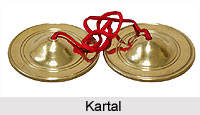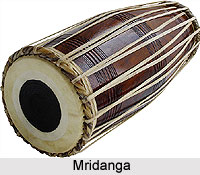 Percussion Instruments in East Indian Folk Music happen to be the most commonly utilized instruments. Out of four major classifications of musical instruments, described by Bharata in Natyashastra, the membrophonic type (percussion) is mostly in vogue in general, because, for all purposes, as in vocal music, dance and other sound effects, Avanaddha Vddya is essentially applied for accompaniment to songs of the folk group. In the folk type rhythmic Avanaddha Vadya (skin-covered-instrument played by stroke) forms the basic omnibus of music.
Percussion Instruments in East Indian Folk Music happen to be the most commonly utilized instruments. Out of four major classifications of musical instruments, described by Bharata in Natyashastra, the membrophonic type (percussion) is mostly in vogue in general, because, for all purposes, as in vocal music, dance and other sound effects, Avanaddha Vddya is essentially applied for accompaniment to songs of the folk group. In the folk type rhythmic Avanaddha Vadya (skin-covered-instrument played by stroke) forms the basic omnibus of music.
A survey of drums in the eastern region of India will indicate innumerable varieties of skin-covered instruments which are unknown in other parts of the country. The fundamental difference occurs in the size of each instrument. The shape and size of drums at various spots differ largely. Starting with the giant drum of the hill people (as used by Kabui Nagas of Manipur and Angami and Ao Nagas of Naga hills) with one-sided coverage of raw and thick skin, varied types are in vogue all over the land. Giant drums were meant for signalling enemy approach, and then gradually these were used for regular rhythmic beats for dance steps. The making of a giant drum needs a heavy round skin and straps of rope/ thread to tighten it in an indigenous method. Heavy wooden block was readily made available by felling a tree, and ultimately it was given a cup-like shape with a huge cavity on one side.

Next to the giant drum, dhak or the master drum of West Bengal beats all other drums in loudness and depth of sound. Dhak is a peculiar instrument which can hardly be compared with a substitute in other areas. Dhak players imitate rhythmic forms from other small instruments. The sound of dhak is, therefore, indicative of the loud sound of a little lighter pitch. The sound does not represent flatness and bass quality.
The name dhol is familiar in different regions of India, though shapes of the instrument differ a little in size. It is fairly a common name for drums. Bengal dhol which is a bifacial membrophonic drum is used in general folk-music. Along with dhol, the other instruments named khol, pung, mridanga, dholak, etc., come under this class.
Khole, one of the most important instruments used in Padavali Kirtan, has been converted into a folk instrument played to devotional folk-songs and panchali singing in West Bengal. This instrument is also familiar in Assam and Orissa. Khol is reverentially treated as a holy instrument (Sri Khol) when used in Padavali Kirtan. The tradition behind the development of this instrument, often named also as Mridanga of Bengal, may be traced to the beginning of Paddvali Kirtan in the sixteenth century or even earlier.
 One of the popular instruments belonging to the tribes of the Austric groups of northern Orissa, Chotanagpur plateau, mid-Bihar and western border of Bengal is familiarly known as madal. Madal referred to by old musicologist means classical types of instrument like pakhawaj. The instrument, madal is widely used in group dances and choral songs of Oraon tribes, Santal tribes, Mundaris and Adibasis of Bengal - Mahatos, Majhis, Ghedias, etc. The shape of the shell of madal, made of burnt clay, is of straight round-pattern, large on one side looking like a cut-out cone. The right-hand side looks small one and the left-hand side is large. Skins of big and small diameter of the two heads are tightened by leather straps, which are run on two circular hoops.
One of the popular instruments belonging to the tribes of the Austric groups of northern Orissa, Chotanagpur plateau, mid-Bihar and western border of Bengal is familiarly known as madal. Madal referred to by old musicologist means classical types of instrument like pakhawaj. The instrument, madal is widely used in group dances and choral songs of Oraon tribes, Santal tribes, Mundaris and Adibasis of Bengal - Mahatos, Majhis, Ghedias, etc. The shape of the shell of madal, made of burnt clay, is of straight round-pattern, large on one side looking like a cut-out cone. The right-hand side looks small one and the left-hand side is large. Skins of big and small diameter of the two heads are tightened by leather straps, which are run on two circular hoops.
Damaru or Dhakka is an instrument connected with a religious festival of Lord Shiva worship. Damaru is found to be a hand-instrument of Lord Shiva significantly used in his dance. These instruments have no special importance in music.
Tikara, an instrument, covered by skin, is played by two thin sticks. It is hung up on the shoulder by ropes. This vessel like monofacial instrument is comparable with the Oriya drum chadchari. The pot-like shape of the instrument is familiar at different places.
Tabla and bayan (dagga, dugi), the most popular percussion instrument all over India, is considered as the main Tala Yantra of today. The high status of this percussion instrument is derived from its technical and artistic development. It also provides rhythmic music in general classical and light songs, and is also used in folk-music and folk-theatre. Tabla produces sounds of pitch or medium notes of various strokes, and bayan emits vibrating base of a little up and down notes by change of pressure of the hand on it. Tabla is a borrowed term, and it creates the confusion as to whether the instrument has been made on the model of a similar Arabic/Persian instrument. The instrument has been taken in folk-music during the third decade of this century, though Baul songs must have adapted duggi a little earlier.
 It should be noted that sounds produced by various types of earthen pots (handi) are also used sometimes with songs but optionally. The open side of the pot is pressed on the belly, and the surface is played by palm and finger. The primary support of music to Avanaddha Vadya (dhak, dhol, khole, khamak, dugi, etc.) is rendered by idiophonic instruments, ghana yddya, metal instruments like kansarjkansi, kartal, mandira, gini, kanjira, ghuhgur, etc. Two pieces held in two hands (kar) is generally named as kartal, though the term has a definite use. These musical instruments were actually adapted by primitive man from things of everyday use like plates, bells, pots, rods, rings, sticks, human bones, horns, available shells, etc., and these were played by beating, rattling, striking crushing, plucking, shaking and rubbing.
It should be noted that sounds produced by various types of earthen pots (handi) are also used sometimes with songs but optionally. The open side of the pot is pressed on the belly, and the surface is played by palm and finger. The primary support of music to Avanaddha Vadya (dhak, dhol, khole, khamak, dugi, etc.) is rendered by idiophonic instruments, ghana yddya, metal instruments like kansarjkansi, kartal, mandira, gini, kanjira, ghuhgur, etc. Two pieces held in two hands (kar) is generally named as kartal, though the term has a definite use. These musical instruments were actually adapted by primitive man from things of everyday use like plates, bells, pots, rods, rings, sticks, human bones, horns, available shells, etc., and these were played by beating, rattling, striking crushing, plucking, shaking and rubbing.
Plate-type instruments (cymbal/struck-plates), kansar/kansi (large and medium both), are played with dhak and dhol respectively. The plates are hung in one hand and played with a stick for rhythmic beating by the other hand, producing open or pressed metallic sound. Assamese bortal may be mentioned along with this.
Next to this is the most familiar instrument karatal (cymbal) - the clapper. Two metal clappers of round shape, held in fingers of two hands (kara), are clashed to produce beats for various talas. This clapper karatal is widely used all over India under different names. In Bengal karatal is the principal supporter to khole-playing.
Mandira and Gimi of Orissa are the smallest pairs of cups of short size held in fingers of two hands, and are gently clashed for the rhythm. It is used methodically with songs of moderate volume. In folk-songs mandira is used in jatra or Pancali songs.
Ghungur and manjira are mostly used in all types of dance-songs and folk-dances. Bunches of moving metal balls with metal stone inside are rattled rhythmically with dancing tala. It is used as ankle bell.
Mention should be made of two peculiar instruments of Assam, toka and gagana. Toka is a bamboo frame or tube which is cut lengthwise and held by hand at one end. It is shaken and rattled for rhythmic variation.




